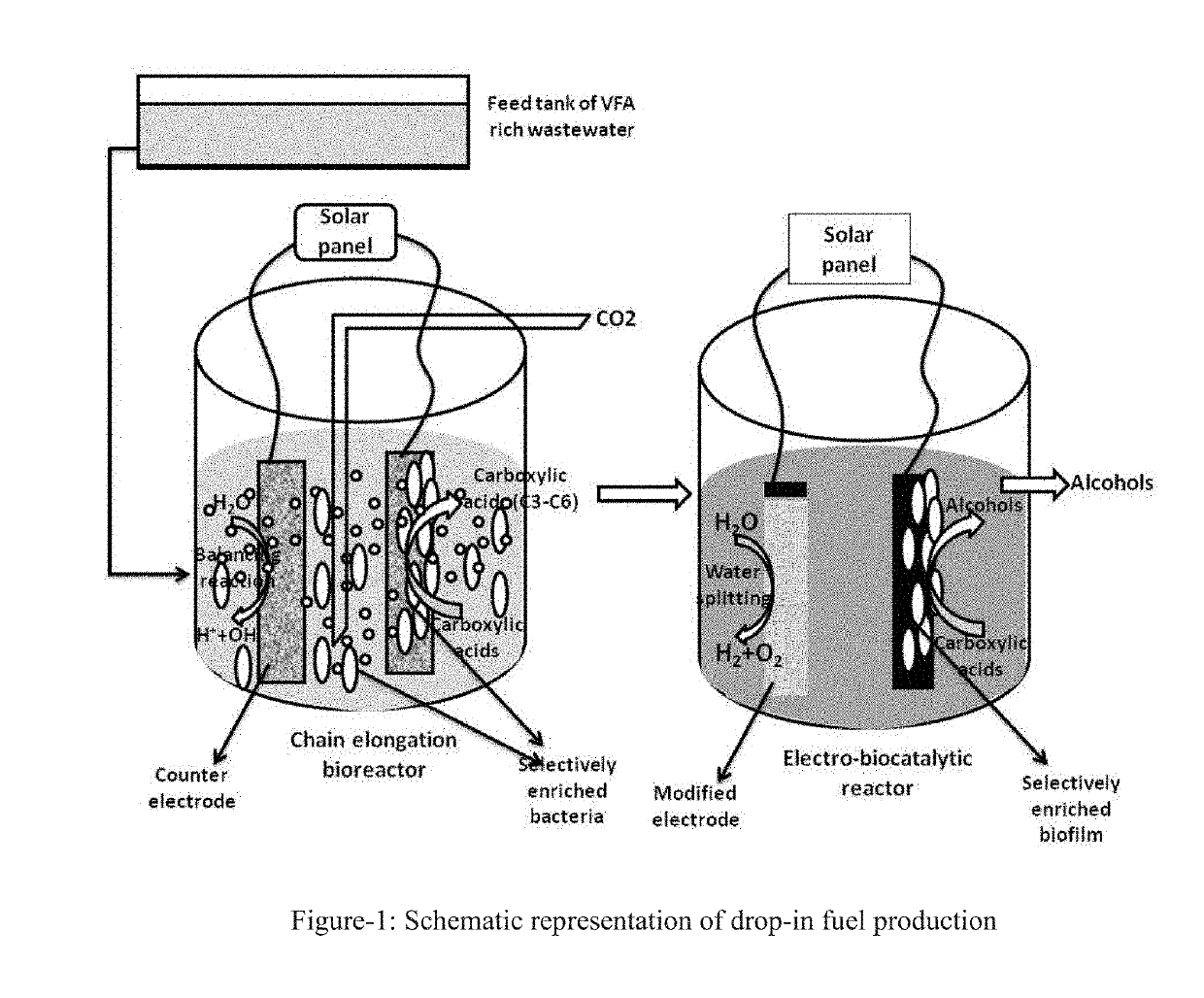Bio-assisted process for conversion of mixed volatile fatty acids to selective drop-in fuels
a technology of volatile fatty acids and bio-assisted process, which is applied in the direction of liquid carbonaceous fuels, electrolytic organic reduction, electrodes, etc., can solve the problems of high energy consumption, high energy consumption, and high cost in the second stage of the process
- Summary
- Abstract
- Description
- Claims
- Application Information
AI Technical Summary
Benefits of technology
Problems solved by technology
Method used
Image
Examples
example 1
General Example
[0069]Experiments were carried out in 2 stages, where the intensification of specific VFA was done during stage-1 followed by the VFA reduction to alcohol in stage-2. The existing fermentors were modified by inserting a pair of electrodes (total / working volume, 2.8 / 2.0 L) and used for this study in both the stage-1 and stage-2. For stage-1 operation, the bioreactor was inserted with graphite rod wrapped with ACC as electrode for oxidation and carbon powder coated graphite rod wrapped with SS mesh as electrode for reduction. Both the electrodes were connected to potentiostat through SS wires and an applied cell potential of +2V was applied to the circuit against Ag / AgCl (3M KCL) reference electrode during stage-1 operation. The current consumption during operation was monitored using chronoamperometry (CA). CO2 alone or along with VFA rich organic waste leachate was used as substrate for stage-1 operation in batch and continuous modes with a retention time of 72 h and ...
example 2
Using CO2 as Sole C-Source
[0071]In one of the examples, the experiment was carried out using CO2 alone as C-source at a rate of 15 ml / min for 72 h of HRT and formic acid (0.5%) as proton source in stage-1. For the reaction, basic media containing NH4Cl of 500 mg / L, MgCl2.6H2O of 160 mg / L, Peptone 250 mg / L Yeast Extract of 26 mg / L along with the trace elements solution (per litre, Nitrilotriacetic acid, 1.5 g; MgSO4×7H2O, 2.0 g; MnSO4×H2O, 1.5 g; NaCl, 1.0 g; FeSO4×7 H2O, 0.1 g; CoSO4×7H2O, 0.134 g; CaCl2×2H2O, 0.1 g; ZnSO4×7H2O, 0.18 g; CuSO4×5H2O, 0.01 g; KAl(SO4)2×12H2O, 0.02 g; H3BO3, 0.01 g; Na2MoO4×2H2O, 0.01 g; NiCl2×6H2O, 0.03 g; Na2SeO3×5H2O, 0.50 mg) and vitamin solution (per litre, biotin, 2 mg; pantothenic acid, 5 mg; B-12, 0.1 mg; p-aminobenzoic acid, 0.25 mg; thioctic acid (alpha lipoic), 5 mg; nicotinic acid, 5 mg; thiamine, 5 mg; riboflavin, 5 mg; pyridoxine HCl, 10 mg; folic acid, 2 mg) was used.
[0072]Rest of the operating conditions was maintained as given in experi...
example 3
Leachate from Kitchen Waste Along with CO2 as C-Source
[0074]In another example, the experiment was carried out using leachate from kitchen waste (VFA: 28.2.4 g / l; TOC: 34.61 g / l) along with CO2 as C-source (15 ml / min) and formic acid was maintained at 0.5% by external addition of required quantity. The combination of Clostridium ljungdahlii, Enterobacter aerogenes MTCC 25016, Pseudomonas fragi MTCC 25025, Pseudomonas stutzferi MTCC 25027 was used as biocatalyst during stage-1. Here also, the current consumption during stage-1 was observed to be increasing with time and in 3 h of operation, it reached 6.1±0.8 A / m2 and sustained afterwards at similar range till 72 h of operation. Results showed the intensification of acetic acid (13.78 g / l) and butyric acids (11.96 g / l) during stage-1 at the expense of other constituents of leachate and CO2 (Table 2).
[0075]The effluent from stage-1 operation was made as substrate for stage-2 of both the approaches and no other C-source was provided fo...
PUM
 Login to View More
Login to View More Abstract
Description
Claims
Application Information
 Login to View More
Login to View More - R&D
- Intellectual Property
- Life Sciences
- Materials
- Tech Scout
- Unparalleled Data Quality
- Higher Quality Content
- 60% Fewer Hallucinations
Browse by: Latest US Patents, China's latest patents, Technical Efficacy Thesaurus, Application Domain, Technology Topic, Popular Technical Reports.
© 2025 PatSnap. All rights reserved.Legal|Privacy policy|Modern Slavery Act Transparency Statement|Sitemap|About US| Contact US: help@patsnap.com

